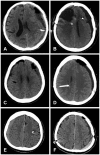Complications Following Burr Hole Craniostomy and Closed-System Drainage for Subdural Lesions
- PMID: 30402421
- PMCID: PMC6218354
- DOI: 10.13004/kjnt.2018.14.2.68
Complications Following Burr Hole Craniostomy and Closed-System Drainage for Subdural Lesions
Abstract
Objective: Burr hole craniostomy and closed-system drainage (BCD) is a common surgical procedure in the field of neurosurgery. However, complications following BCD have seldom been reported. The purpose of this study was to report our experiences regarding complications following BCD for subdural lesions.
Methods: A retrospective study of all consecutive patients who underwent BCD for presumed subdural lesions at one institute since the opening of the hospital was performed.
Results: Of the 395 patients who underwent BCD for presumed subdural lesions, 117 experienced surgical or nonsurgical complications. Acute intracranial hemorrhagic complications developed in 14 patients (3.5%). Among these, 1 patient died and 5 patients had major morbidities. Malposition of the drainage catheter in the brain parenchyma occurred in 4 patients, and opposite-side surgery occurred in 2 patients. Newly developed seizures after BCD occurred in 8 patients (2.0%), five of whom developed the seizures in relation to new brain lesions. Eighty-eight patients (22.3%) suffered from nonsurgical complications after BCD. Pulmonary problems (7.3%) were the most common nonsurgical complications, followed by urinary problems (5.8%), psychologic problems (4.3%), and cognitive impairments (3.8%).
Conclusion: The incidence of complications after BCD for subdural lesions is higher than previously believed. In particular, catastrophic complications such as acute intracranial hematomas and surgical or management errors occur at rates that cannot be ignored, possibly causing medico-legal problems. Great caution must be taken during surgery and the postoperative period, and these complications should be listed on the informed consent form before surgery.
Keywords: Hematoma, subdural, chronic; Postoperative complications; Trephining.
Conflict of interest statement
The authors have no financial conflicts of interest.
Figures

Similar articles
-
Complications of burr-hole craniostomy and closed-system drainage for chronic subdural hematomas: a retrospective analysis of 376 patients.Neurosurg Rev. 2002 Mar;25(1-2):89-94. doi: 10.1007/s101430100182. Neurosurg Rev. 2002. PMID: 11954771
-
Randomized comparative study of burr-hole craniostomy versus twist drill craniostomy; surgical management of unilateral hemispheric chronic subdural hematomas.Zentralbl Neurochir. 2008 Aug;69(3):129-33. doi: 10.1055/s-2007-1004587. Epub 2008 Jul 29. Zentralbl Neurochir. 2008. PMID: 18666056 Clinical Trial.
-
The use of endoscopic-assisted burr-hole craniostomy for septated chronic subdural haematoma: A retrospective cohort comparison study.Brain Res. 2018 Jan 1;1678:245-253. doi: 10.1016/j.brainres.2017.10.017. Epub 2017 Oct 24. Brain Res. 2018. PMID: 29074342
-
The course of chronic subdural hematomas after burr-hole craniostomy with and without closed-system drainage.Neurosurg Clin N Am. 2000 Jul;11(3):541-6. Neurosurg Clin N Am. 2000. PMID: 10918027 Review.
-
Twist drill craniostomy vs burr hole drainage of chronic subdural hematoma: a systematic review and meta-analysis.Acta Neurochir (Wien). 2021 Dec;163(12):3229-3241. doi: 10.1007/s00701-021-05019-3. Epub 2021 Oct 14. Acta Neurochir (Wien). 2021. PMID: 34647183
Cited by
-
Additional treatment after primary conservative treatment in patients with chronic subdural hematoma-A retrospective study.Brain Behav. 2024 Jul;14(7):e3590. doi: 10.1002/brb3.3590. Brain Behav. 2024. PMID: 38956812 Free PMC article.
-
Risk of recurrence of subdural hematoma after EMMA vs surgical drainage - Systematic review and meta-analysis.Interv Neuroradiol. 2021 Aug;27(4):577-583. doi: 10.1177/1591019921990962. Epub 2021 Feb 1. Interv Neuroradiol. 2021. PMID: 33525919 Free PMC article.
-
Trauma Mechanisms and Surgical Outcomes in the Elderly Patient with Chronic Subdural Hematoma.Can Geriatr J. 2022 Mar 2;25(1):40-48. doi: 10.5770/cgj.25.519. eCollection 2022 Mar. Can Geriatr J. 2022. PMID: 35310470 Free PMC article.
-
Delayed Multiple Intracerebral Hemorrhage After Burr Hole Drainage of Chronic Subdural Hematoma During Failure of Warfarin Resumption in Atrial Fibrillation.Korean J Neurotrauma. 2022 Feb 17;18(1):83-88. doi: 10.13004/kjnt.2022.18.e9. eCollection 2022 Apr. Korean J Neurotrauma. 2022. PMID: 35557631 Free PMC article.
References
-
- Ducruet AF, Grobelny BT, Zacharia BE, Hickman ZL, DeRosa PL, Andersen KN, et al. The surgical management of chronic subdural hematoma. Neurosurg Rev. 2012;35:155–169. - PubMed
-
- Gazzeri R, Galarza M, Neroni M, Canova A, Refice GM, Esposito S. Continuous subgaleal suction drainage for the treatment of chronic subdural haematoma. Acta Neurochir (Wien) 2007;149:487–493. - PubMed
LinkOut - more resources
Full Text Sources

